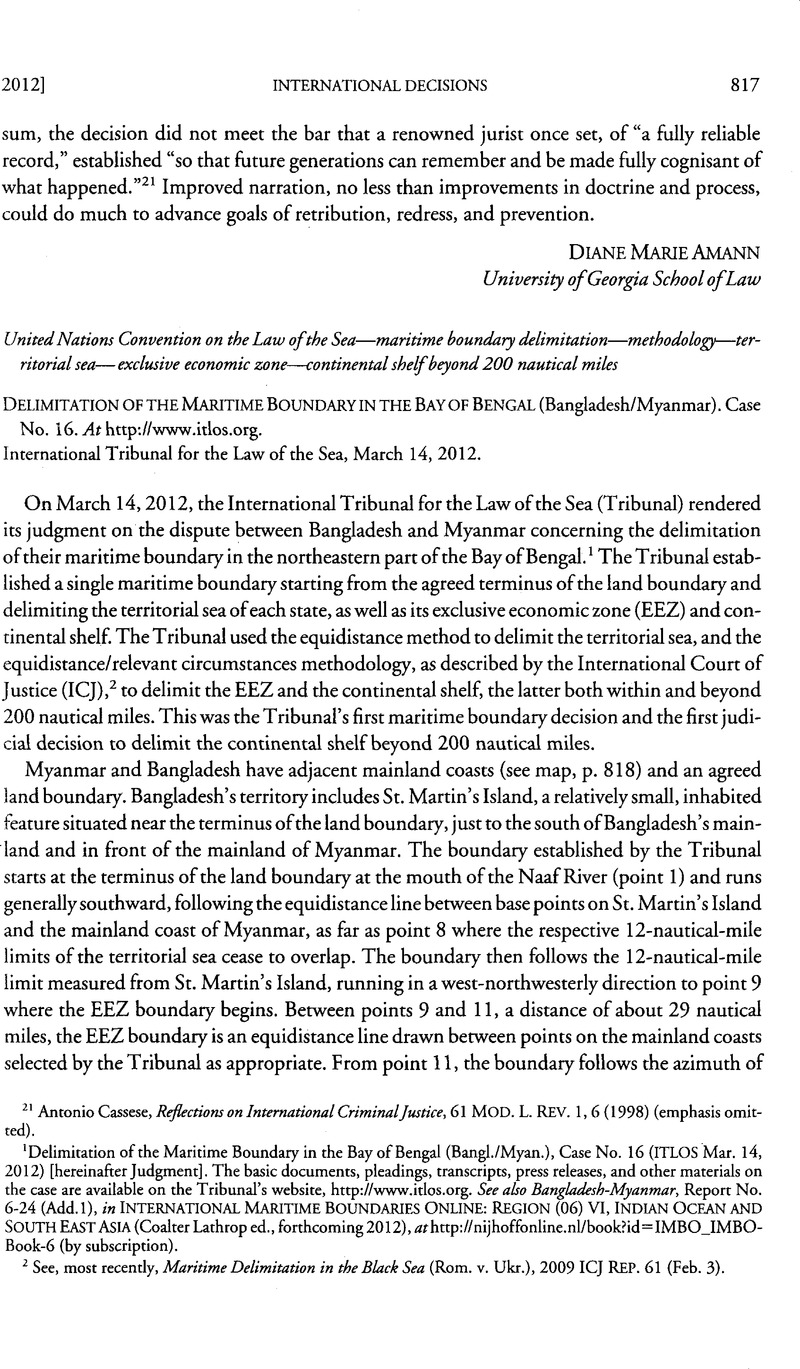Published online by Cambridge University Press: 20 January 2017

1 Delimitation of the Maritime Boundary in the Bay of Bengal (Bangl./Myan.), Case No. 16 (ITLOS Mar. 14, 2012) [hereinafter Judgment]. The basic documents, pleadings, transcripts, press releases, and other materials on the case are available on the Tribunal‘s website, http://www.itlos.org. see also Bangladesh-Myanmar, Report No. 6-24 (Add.1), in International Maritime Boundaries Online: Region (06) Vi, Indian Ocean and South East Asia (Coalter Lathrop ed., forthcoming 2012), at http://nijhoffonline.nl/book?id=IMBO_IMBO-Book-6 (by subscription).
2 See, most recently, Maritime Delimitation in the Bkck Sea (Rom. v. Ukr.), 2009 ICJ Rep. 61 (Feb. 3).
3 Myanmar’s submission and later submissions by India and by Bangladesh are available online through the link to the Commission at http://www.un.org/depts/los/. The claims to areas of the continental shelf in the Bay of Bengal overlap. The Commission decided to defer its consideration of the submissions in view of the unresolved delimitation disputes.
4 United Nations Convention on the Law of the Sea, opened for signature Dec. 10, 1982, 1833 Unts 3, available at http://www.un.org/depts/los/.
5 Vienna Convention on the Law of Treaties, Art. 7(1), (2), opened for signature May 23, 1969, 1155 UNTS 331.
6 Article 15 of the Convention, supra note 4, provides, in pertinent part:
Where the coasts of two States are opposite or adjacent to each other, neither of the two States is entitled, failing agreement between them to the contrary, to extend its territorial sea beyond the median line every point of which is equidistant from the nearest points on the baselines from which the breadth of the territorial sea of each of the two States is measured. This provision does not apply where special circumstances require delimitation at variance with it.
7 This feature is also known as “Bluff Cape.”
8 Maritime Delimitation in the Black Sea (Rom. v. Ukr.), 2009 ICJ Rep. 61 (Feb. 3).
9 The Tribunal’s provisional equidistance line is shown in sketch-map No. 5. See Judgment following paras. 271-74.
10 North Sea Continental Shelf (Frg/Den.; FRG/Neth.), 1969 ICJ Rep. 3 (Feb. 20).
11 Delimitation of the Maritime Boundary Between Guinea and Guinea-Bissau, 25 ILM 251 (1986), 77 ILR 635 (ad hoc arb. trib. Feb. 14, 1985).
12 The judgment does not discuss the possibility of according the island less than full weight. Illustration Map 2, attached to Separate Opinion of Judge Gao, shows full, half, and no effect for the island.
13 There are several agreements in the six volumes of International Maritime Boundaries, edited variously by Jonathan I. Charney, Lewis M. Alexander, Robert W. Smith, and David Colson (1993-2011), defining boundaries extending beyond the 200-nautical-mile limit.
14 Different approaches over methodology are indicated in the Joint Declaration of Judges Nelson, Chandrasekhara Rao, and Cot; the Separate Opinion of Judge Cot; and the Separate Opinion of Judge Gao, all attached to the Judgment.
15 Statute of the International Tribunal for the Law of the Sea, Art. 31, Convention, supra note 4, Annex VI.
16 Bangladesh v. India (filed Oct. 8, 2009). For details, see Bangladesh v. India, at http://www.pca-cap.org/showpage.asp?pag_id=1376.